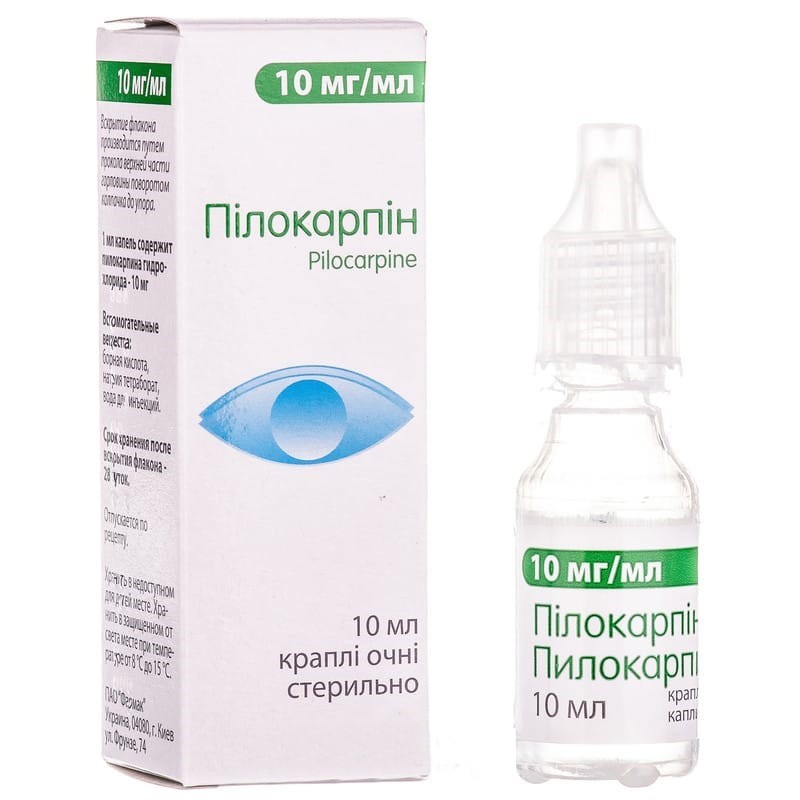



 Secure and encrypted payment processing
Secure and encrypted payment processing We ship to over 40 countries including the USA, UK, Europe, Australia and Japan
We ship to over 40 countries including the USA, UK, Europe, Australia and Japan Guaranteed refund or reship if you haven't received your order
Guaranteed refund or reship if you haven't received your orderpilocarpine hydrochloride refers to m-cholinomimetic agents. the mechanism of action is due to the excitation of peripheral m-cholinergic receptors, which causes contraction of the circular muscle of the iris and ciliary muscle, is accompanied by a narrowing of the pupil and opening of the anterior chamber angle of the eye, an improvement in the outflow of intraocular fluid, which generally causes a decrease in intraocular pressure and improves trophic processes in the tissues of the eye. decrease in ophthalmotonus reaches 3-4 mm RT. Art.
Pharmacokinetics When instilled into the pilocarpine conjunctiva, the hydrochloride penetrates the cornea and is maximally concentrated in the aqueous humor of the eye after 30–40 minutes. T½ from the eye - 1.5–2 hours, nevertheless, the effect of the drug on the level of intraocular pressure lasts for 4–8 hours. Pilocarpine hydrochloride is not metabolized in the tissues of the eye, but is excreted together with intraocular fluid, inactivated by hydrolysis in blood serum and liver . T½ from blood plasma - 30 min.
Primary and chronic open-angle glaucoma. acute attack of angle-closure glaucoma. chronic angle-closure glaucoma (before surgery). secondary glaucoma (as a result of central retinal vein thrombosis, acute obstruction of the retinal artery, optic atrophy, retinal pigment degeneration, vitreous hemorrhage). the need to narrow the pupil during an overdose of mydriatics, with a diagnostic purpose and during surgical interventions (except for persons with high myopia).
Pilocarpine is instilled into each eye 1-2 drops 2-4 times a day. The daily dose and duration of the course of treatment is determined by the doctor depending on the level of intraocular pressure. if necessary, the drug can be combined with β-adrenergic blockers.
In an acute attack of angle-closure glaucoma, Pilocarpine is prescribed: for the first hour - every 15 minutes, 1 drop; for 2-3 hours - every 30 minutes, 1 drop; for 4-6 hours - every 60 minutes, 1 drop; further - 3–6 times a day until the attack is stopped.
Iritis, iridocyclitis, iridocyclical crisis, uveitis, cyclitis, keratitis and other eye diseases in which pupil constriction is undesirable (after eye surgery to prevent posterior synechia). paradoxical reaction to the drug with stagnant form of glaucoma.
Pilocarpine should be used in patients with a history of retinal detachment, young people with high myopia. Acute inflammatory diseases of the eye tissue. Allergic reactions to the components of the drug and a history of asthma.
During the use of pilocarpine, the following may develop:
Immediately before use, you should hold the bottle with the drug in the palm of your hand to warm it to body temperature.the cap is unscrewed, removed and, slightly pressing on the body of the bottle, bury the solution in the eye. After instillation, the cap is tightly screwed.
Use with caution in patients with acute heart failure, recent myocardial infarction, severe bradycardia, hypotension, hypertension, hyperthyroidism, epilepsy, urinary tract obstruction, vasomotor instability, Parkinsons disease.
Miotic preparations are used in the absence of newly formed vessels in the iris.
An increase in the concentration and frequency of instillation (≥6) is impractical because it does not lead to an increase in the hypotensive effect and causes general negative reactions of the body.
Pilocarpine practically does not affect the level of ophthalmotonus in healthy people, but is effective in patients with glaucoma of various forms. It is advisable to replace Pilocarpine for 1-3 months throughout the year with other non-miotic drugs. With prolonged instillation, miosis persists all the time, which is important for the elderly with phacosclerosis and cataracts of the initial stage.
Use during pregnancy and lactation. Use during pregnancy and lactation is possible only if, in the opinion of the doctor, the expected effect exceeds the risk of possible adverse reactions.
Children. The drug is not used in children.
The ability to influence the reaction rate when driving vehicles or working with other mechanisms. When using the drug, it is not recommended to drive vehicles and engage in other potentially dangerous activities that require clear vision.
Atropine and other m-anticholinergic drugs are antagonists of pilocarpine. with simultaneous use with adrenostimulants, antagonism of action (effect on pupil diameter) may be noted.
Timolol and mesatone increase the decrease in intraocular pressure.
Pilocarpine may be used in combination with β-adrenergic blockers, carbonic anhydrase inhibitors.
M-anticholinergic effect of Pilocarpine is reduced when combined with tricyclic antidepressants, phenothiazine derivatives, chlorprotixen, clozapine; amplified by anticholinesterase drugs.
The occurrence of bradycardia and a decrease in blood pressure during general anesthesia with the use of fluorotan (in patients using pilocarpine in the form of eye drops).
The first symptoms of an overdose are nausea, bradycardia, persistent miosis, eye pain, visual impairment, headache can develop. with the appearance of these symptoms, the drug is canceled. symptomatic overdose treatment. atropine, tropicamide can be used as specific antidotes. with severe bradycardia due to an overdose of parasympathomimetics, 0.5–2 mg of atropine is administered parenterally.
In the dark place at a temperature of 8-15 ° c.